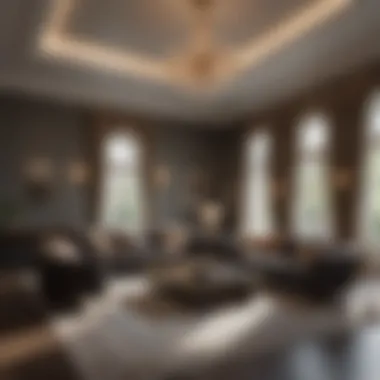Exploring the Most Expensive Homes in the US Market


Intro
The landscape of luxury real estate in the United States is constantly evolving. Knowing the intricate details of the most expensive homes provides insights not only into the properties themselves but also into broader economic trends and consumer behavior among ultra-high-net-worth individuals. This article aims to delve into the elements that raise property values in this segment, highlight current market trends, and examine the broader implications of economic factors on this elite sector of real estate.
Understanding these aspects is crucial for investors and enthusiasts who are keen on engaging with the luxury market. This exploration will cover various locations, noteworthy properties, and the surrounding economic conditions that contribute to the allure of these magnificent homes.
Market Overview
The luxury home market in the U.S. is a reflection of the wellness of various economic indicators. Price fluctuations in this sector usually coincide with macroeconomic trends. High demand typically meets limited supply, especially in prime locations.
Current Market Trends
Recent trends show a surge in demand for luxury homes even amidst economic volatility. Features like private amenities, expansive outdoor spaces, and sustainable building practices are increasingly sought after. The market has also seen a rise in international buyers investing in U.S. properties, attracted by favorable exchange rates and a stable economic climate.
Economic Indicators Impacting the Market
Key economic indicators affecting the luxury homes market include interest rates, employment rates, and GDP growth. Lower interest rates have led to increased buying power for wealthy individuals, encouraging more purchases in high-value residential areas. The increase in disposable income among the affluent demographic further supports this market.
Global Influences and Major Events
Global economic trends can have local impacts. Events like geopolitical tensions or economic downturns in foreign markets often lead wealthy individuals to seek safe investments in real estate. Recent events have shown that even crises can result in a shift in demand towards ultra-expensive homes in resilient markets such as California and New York.
Preface to Luxury Real Estate
The domain of luxury real estate represents more than just high-value properties. It encompasses an intricate landscape shaped by wealth trends, affluent lifestyles, and unique architectural designs. In the world of luxury homes, understanding what defines luxury itself serves as a cornerstone for investors and enthusiasts alike. This article delves into essential characteristics that elevate homes in value, making them not just residences but also symbols of prestige and investment potential.
Defining Luxury in Real Estate
Luxury in real estate is often perceived through several lenses. It is not solely about an exorbitant price tag; it incorporates various elements that enhance a property's allure. Factors such as exclusive locations, high-end materials, and bespoke architectural features contribute significantly to defining luxury homes.
- Location: A prime location typically commands higher prices. Proximity to amenities, scenic views, and privacy play important roles.
- Amenities: Features such as swimming pools, home theaters, and smart home technology can increase a property's desirability.
- Architecture and Design: Unique architectural elements, historical significance, and innovative designs set these properties apart from conventional homes.
This multifaceted definition is dynamic and can shift with global trends, societal changes, and economic fluctuations.
Trends in the Luxury Market
The luxury real estate market is characterized by trends that reflect shifting consumer preferences and economic conditions. Analyzing these trends is vital for understanding where the market is heading.
- Increased Demand for Sustainable Homes: Eco-friendly designs are increasingly in demand. Many buyers prioritize energy-efficient features and sustainable materials in their home purchases.
- Interest from International Buyers: Wealth from abroad continues to flow into the U.S. luxury market, particularly from regions like China and Europe.
- Remote Work Influence: The rise of remote work has reshaped buyer preferences, leading to increased interest in spacious homes in suburban or rural areas, often away from city centers.


The dynamics of the luxury real estate market indicate a shift towards homes that not only offer comfort but also align with buyers' evolving values and lifestyle choices.
Understanding these elements provides insight into the motivations driving luxury real estate investments and the evolving landscape of high-end residential living.
Characteristics of Highly Valued Properties
In the realm of luxury real estate, certain properties stand out due to their distinctive features and exceptional value. Understanding the characteristics of highly valued properties is crucial for potential investors, real estate professionals, and anyone interested in the luxury market. Various elements influence a property's worth, including location, architecture, and technology. Recognizing these factors offers insights into investment opportunities and market trends in the luxury sector.
Location and Market Demand
Location serves as the cornerstone for real estate valuation. High-value homes often sit in prime areas known for their desirability, such as Beverly Hills or Manhattan. Proximity to amenities, such as cultural institutions, upscale shopping, and elite schools, enhances these properties' attractiveness.
Market demand also fluctuates based on various socio-economic elements. Cities like San Francisco and Miami have seen surges in demand driven by tech wealth or demographics. Buyers often pay a premium for homes in neighborhoods that are on the rise or known for exclusivity. Situations where supply is constrained lead to competitive bidding, further driving prices upward.
"In luxury real estate, it is often about ‘who’ is buying and ‘where’ the property is located that determines its market value."
This relationship between location and market demand is critical for anyone considering investment in luxury residential properties.
Architectural Significance
Architectural distinction contributes significantly to the value of high-end homes. Unique designs that reflect both historical and modern styles attract discerning buyers. Renowned architects often amplify a property's appeal. Homes designed by famous figures such as Frank Lloyd Wright or Zaha Hadid can command premium prices.
Details such as quality materials, innovative floor plans, and exceptional craftsmanship further enhance valuations. Potential buyers often seek properties that not only serve a function but also provide aesthetic satisfaction. In this scenario, classic characteristics may include grand entryways, open floor plans, and expansive windows that seamlessly blend indoor and outdoor living.
Technological Advancements in Homes
The integration of technology in residential properties has become a pivotal element in increasing value. Buyers increasingly seek smart homes equipped with advanced systems for security, energy efficiency, and comfort. Technologies such as integrated home automation, energy-efficient appliances, and advanced climate control systems are no longer luxury add-ons but essential features.
Many high-end properties now include smart home systems that allow for remote operation of lighting, climate, and security systems. Innovations like solar panels, green building materials, and sustainable design practices add to a home's allure and financial viability. This increasing emphasis on sustainability is shaping how new luxury homes are built and positioned in the market.
In summary, understanding the characteristics of highly valued properties lays the groundwork for navigating the luxury real estate landscape effectively. Awareness of location dynamics, architectural significance, and technology integration is essential for making informed investment decisions.
Notable Homes on the Market
The segment discussing notable homes on the market is crucial to understanding the luxury real estate landscape in the United States. These properties serve as benchmarks for value, showcasing the pinnacle of architectural design and prime location. Each listing tells a story about wealth, aspiration, and lifestyle. Analyzing these high-profile homes provides insightful data on market trends, buyer preferences, and investment opportunities in the luxury sector.
Identifying what makes these homes notable can assist potential investors in discerning where to place their capital, based on historical appreciation and current market conditions. Furthermore, these properties often act as economic indicators, reflecting shifts in the luxury market and the behaviors of ultra-high-net-worth individuals.
California’s Billion-Dollar Listings


California's luxury market is known for its billion-dollar listings, presenting some of the most expensive homes in the world. Properties such as those in the exclusive neighborhoods of Beverly Hills, Malibu, and San Francisco often feature stunning ocean views, expansive estates, and luxurious amenities.
A prime example is The One, a mega-mansion in Bel Air, listed for $500 million. This 105,000 square foot property boasts 20 bedrooms, a nightclub, and a four-lane bowling alley. The draw of California real estate is not just the properties, but also the lifestyle associated with them, which includes a blend of entertainment, climate, and social scenes.
New York’s Iconic Properties
New York City is synonymous with luxury and has properties that embody urban opulence. In neighborhoods such as Manhattan, listings often reach astronomical prices, reflecting the vibrant culture and lifestyle of the city.
One significant property is 432 Park Avenue, known for its striking design and status in the New York skyline. Its average price per square foot stands among the highest in the city, making it a coveted address. Buyers are drawn not only to the property itself but also to New York's status as a global financial hub, influencing wealth and investment opportunities.
Florida’s Waterfront Estates
Florida is home to some exquisite waterfront estates that cater to affluent buyers seeking serenity alongside luxury. Coastal cities such as Palm Beach and Miami showcase properties that provide direct access to stunning beaches and exclusive communities.
A noteworthy example is La Follia, an estate located in Palm Beach. This property is renowned for its Mediterranean architecture and beautifully landscaped grounds. The appeal of Florida real estate lies in its favorable tax environment, combined with a lifestyle that emphasizes outdoor living, making it an attractive option for high-net-worth individuals looking to invest in a luxurious yet relaxed setting.
Economic Influences on Luxury Homes
Understanding the economic influences on luxury homes is essential for grasping the dynamics of this exclusive real estate segment. Economic factors can significantly dictate the demand, price, and investment opportunities associated with high-end properties. In this section, we will delve into the various elements, exploring how they shape the luxury housing market.
Impact of Global Wealth Distribution
Global wealth distribution plays a critical role in the luxury housing market. By analyzing the concentration of wealth among the elite, we can understand where demand for expensive homes is likely to arise. Countries like the United States, China, and the United Kingdom are notable for housing a significant number of ultra-high-net-worth individuals.
As wealth becomes increasingly concentrated, it leads to more competition among buyers for prestigious properties. This trend results in escalating prices, particularly in sought-after areas like Beverly Hills or Manhattan. Moreover, the influx of international investors does not just influence the local markets but also shifts global trends. For example, when wealthy individuals from overseas purchase properties in the US, they often drive prices higher, creating a ripple effect in the housing market.
Interest Rates and Mortgages
Interest rates hold substantial sway over the luxury home segment. Fluctuating rates can define the purchasing power of buyers looking to invest in high-value property. Lower interest rates tend to aid buyers, allowing them to afford homes that may have otherwise been out of reach. Conversely, rising interest rates can lead to stricter lending policies and lower demand, resulting in stagnation of the market as seen in previous economic cycles.
To adapt to the changing rates, buyers and investors often consider adjustable-rate mortgages. These can offer lower initial payments but come with the risk of rising costs in the future. Therefore, understanding current interest rate trends is crucial for anyone looking into luxury real estate as both a financial investment and a personal asset.
Investment Trends Among High-Net-Worth Individuals
High-net-worth individuals frequently shape the luxury housing market through their unique investment trends. Typically, these buyers are searching for both aesthetic value and potential financial gain. They are not merely acquiring residences; they are investing in status symbols that often appreciate over time.
Several trends have emerged in recent years:
- Diversification of Assets: Many wealthy individuals prefer to diversify their real estate portfolios. They might invest in various markets, seeking out luxury properties in stable economies.
- Focus on Amenities: High-end buyers are demanding modern amenities that enhance their lifestyles. Features like smart home technology, expansive outdoor spaces, and wellness facilities are becoming more standard.
- Sustainability: There is a growing trend towards eco-friendly residences. Luxurious homes designed with sustainability features are increasingly attractive to wealth holders who value both style and responsibility.


"The luxury housing market is heavily influenced by the financial habits and preferences of high-net-worth individuals, impacting demand and residential choices."
The Future of Luxury Real Estate
The domain of luxury real estate is in a constant state of evolution. Understanding the future of luxury homes is not merely about tracking prices; it involves scrutinizing the broader socioeconomic trends and shifts in buyer preferences. This section aims to highlight some significant elements shaping the luxury real estate landscape. Recognizing these trends can provide valuable insight for individual investors, finance enthusiasts, and professional traders.
Sustainability and Eco-Friendly Design
The increasing emphasis on sustainability in luxury real estate is not just a trend; it is a necessity in today’s world. Homebuyers are now seeking eco-friendly features that mitigate environmental impact while enhancing energy efficiency. Homes equipped with solar panels, energy-efficient appliances, and sustainable materials are becoming more desirable.
Moreover, certifications such as LEED (Leadership in Energy and Environmental Design) can add significant value to a property. Let's consider some examples:
- Sustainable Landscaping: These designs focus on native plants that require less water.
- Smart Home Technologies: Monitoring energy consumption and automating systems can optimize overall energy use.
Investing in sustainable features not only aligns with ethical consumerism but often results in lower utility bills, increasing the home's long-term value.
The Role of International Buyers
The influence of international buyers on the luxury real estate market is profound. These buyers are often attracted by the stability, lifestyle, and investment potential of U.S. properties. Regions like Florida and California have seen significant interest from overseas investors. Notable aspects include:
- Diverse Investment Portfolios: International buyers frequently view U.S. real estate as a method to diversify their assets.
- Desire for Luxury Lifestyle: Properties near cultural landmarks or exclusive amenities are especially appealing.
This influx of international funds can drive up prices and influence local market dynamics. As global wealth shifts, understanding these buyers becomes crucial for those looking to invest wisely.
Changing Preferences in Home Features
As societal norms evolve, so do the expectations surrounding luxury homes. Modern buyers are prioritizing different features compared to previous generations. Here are some notable shifts:
- Home Offices: The recent increase in remote work has made dedicated office space a sought-after feature.
- Wellness Amenities: Pools, gyms, and outdoor spaces that promote well-being are increasingly favored.
- Smart Home Integration: Systems that offer convenience and security are in demand.
This evolution in preferences should not be underestimated. Investors should pay attention to these trends to better understand how they can influence property values moving forward.
Investing in a property that incorporates future-focused features is essential for maximizing returns in the luxury real estate market.
By keeping a pulse on these changing dynamics, investors can identify opportunities that align with current market demands.
The End
The exploration of costly homes in the United States offers crucial insights for any investor or real estate enthusiast. Understanding luxury properties not only enhances one’s knowledge but also informs decision-making processes regarding investments.
Key Takeaways on Luxury Properties
Luxury homes often reflect broader market trends. Factors such as location, design, and technology play significant roles in determining value. The key elements include:
- Location: The most critical factor impacting the value. Prestigious addresses often come with astronomical prices.
- Design and Architecture: Unique architectural elements and high-quality materials can greatly enhance desirability.
- Technological Integration: Smart home technologies and eco-friendly solutions are increasingly seen in upscale residences.



